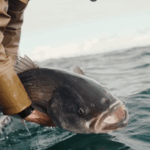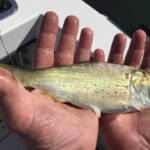
Release Mortality Revisited: New Research from Massachusetts DMF
Feature Photo Credit: Robbie Tartaglia What’s going on? For decades, striped bass management relied on a

When is rains, it pours in the Chesapeake Bay
Originally Published Here on Fissues
By Tony Friedrich
Right now, the Chesapeake region is experiencing unprecedented rains. In May, Ellicott City experienced a “once in a thousand-year flood,” for the second time in two years. July 2018 saw the most rain for that month on record. Between July 19 and 26, the Chesapeake Watershed had rainfall totals reaching almost 15 inches. That doesn’t include rain earlier in the month or the floods in May.
Let’s talk about Hurricane Agnes for the sake of comparison. Agnes, which made landfall in 1972, was one of the most devastating events in Chesapeake Bay history. The image below depicts side-by-side rain totals for Agnes and July 19-26, 2018. As you can see, we’ve received a staggering amount of moisture. While Agnes was probably more damaging, fishermen and fisheries will feel the effects of July 2018 rains for years to come.

All that water rushed down Mid Atlantic tributaries and ultimately met with the Conowingo Dam on the Susquehanna River. Historical flow for this time of year is about 13,000 cubic feet per second (CFS). The flow peaked earlier in the week at almost 400,000 CFS, with a river height of about 26 feet. Again, for comparison, in 1972, after Agnus, the river was moving 1.1 million cubic feet per second with a river height of 36 feet. In 2011, Tropical Storm Lee brought the river height to 32.14 feet. So this flood from an unnamed rain event has had an impact that measures up to tropical systems.

The result is an incredible amount of filthy fresh water entering a brackish estuary. The floods picked up every tree, shrub, and piece of garbage along all the tributaries and deposited them into the bay. The flooding also carries untold tons of phosphorous and nitrogen from fertilizers and manure—the last thing that Chesapeake Bay needs. And the debris fields are so significant that Maryland Department of Natural Resources issued warnings for boaters for the bay.

Debris at Sandy Point State Park at the North end of the Bay Bridge
Image Credit: Donna Cole
Satelite images show the story. The mocha brown part of the photo below is actually the Northern part of the bay. The stained flood waters extend to the Southern tip of Kent Island now, approximately 15 miles south of the bridge. In shallow areas, this will complicate bay grass recovery by blocking sunlight, thereby limiting photosynthesis. In deeper areas, nutrient driven algae blooms will die and settle on the bottom, depleting oxygen in the process.

The runoff will likely cause dead zones to expand, and obviously areas with little or no dissolved oxygen are bad for fish. In the northern bay, the fish are now congregated where there’s enough turnover caused by wind and waves to whip some oxygen into the water. It’s an awful example of “habitat compression.” With the fish more restricted to certain areas, they are easier to target. And catch-and-release isn’t a viable option in 82-degree, low-salinity water. The fish just won’t survive.
Adult and early juvenile populations of stripers will likely suffer, which has implications for regulations on the species. We will know what the deluges dealt to this year class come September, when fisheries scientists sample for estimates of juvenile abundance.
More concerning, in terms of human health and safety is the amount of other possible contaminants. There has been a problem brewing at the head of the bay for years. When the Conowingo Dam was built in 1928, the river water impounded by the dam formed a 14-mile reservoir. This body of water effectively trapped much of the sediment and everything in it. Over time, the reservoir has filled in. Currently, it has lost capacity to stop nutrient and sediment runoff. All the bad stuff trapped in the mud gets scoured during large floods. So, imagine every chemical that our country has used since 1928. That’s what’s getting released during these events.
We have a massive problem. The reservoir upstream from the dam was very good at trapping the bad stuff for almost 100 years. The stuff that filled it in is pretty bad. The dam can’t stop the runoff, including everything from large trees, soda machines, tires, and even a few couches, anymore. So, we are getting hit with a double whammy. Knowing that the sediment has got some DDT with a splash mercury and PCB, dredging is a complicated issue and potentially dangerous. It is estimated that dredging the reservoir would cost almost 3 billion dollars annually just to keep up with new material. That doesn’t cover addressing the stuff that’s already there. Then you have the issue of where to put the dredge spoils.
Like most issues of this nature, this one is quite contentious. We are in the middle of the pointing fingers stage. Excelon, the owner of the dam, is seeking a renewal of its license. The renewal process includes Maryland giving clearance that the dam won’t impact water quality. Maryland issued the certification with a caveat that Excelon would have to pay about 7 billion dollars over the next 50 years to address the excess nitrogen and phosphorus that is no longer trapped be the reservoir. Excelon responded with a lawsuit in federal and state court. The price tag outweighs the value of the dam. The riverkeepers, not to be left out, said the 7 billion wasn’t enough and filed an appeal with Maryland.
I’m no fan of dams. First and foremost, they block anadromous fish from spawning and alter migrational routes. They also alter the natural balance of the system. The license renewal included a huge project to create a fish passage for American shad and herring. That’s on hold now. Blaming a huge power company seems like the easy way out. It is reasonable to say that Conowingo Dam has effectively trapped an incredible amount of bad stuff thereby helping the situation. Excelon didn’t put the bad stuff in the river. So while I’m not a dam proponent, the blame doesn’t fall all on Excelon. It is scary to think what would happen if the material behind the dam washed into the bay.
This is a serious problem with no easy fix and no one entity to blame. It took a long time to get here, and it will take a long time to get out of it. Right now, the bay is hurting from the heavy rains. .That won’t go away anytime soon. While the attorneys battle it out, we will all brace for what’s to come.

Feature Photo Credit: Robbie Tartaglia What’s going on? For decades, striped bass management relied on a

Recent developments in the 2025 Atlantic Menhaden Stock Assessment Update, released by the Atlantic States

What’s going on? The “most important fish in the sea” just exposed one of the

Mario CampoFisheries Ecologist, Southeastern Louisiana UniversityScience and Policy Associate, American Saltwater Guides Association This discussion
We rely on our members and donations to keep fighting for a sustainable tomorrow in marine conservation.
GIVE THE GIFT OF FISHERIES CONSERVATION THIS HOLIDAY SEASON. SHOP ASGA GOODS THAT FUND FISHERIES RESEARCH & ADVOCACY CAMPAIGNS
JOIN ASGA IN CALLING FOR CRITICAL MANAGEMENT ACTION AFTER YEARS OF SPAWN FAILURES & POOR MANAGEMENT.
By using this website, you agree to our use of cookies. We use cookies to provide you with a great experience and to help our website run effectively. To learn more, please review our privacy policy.